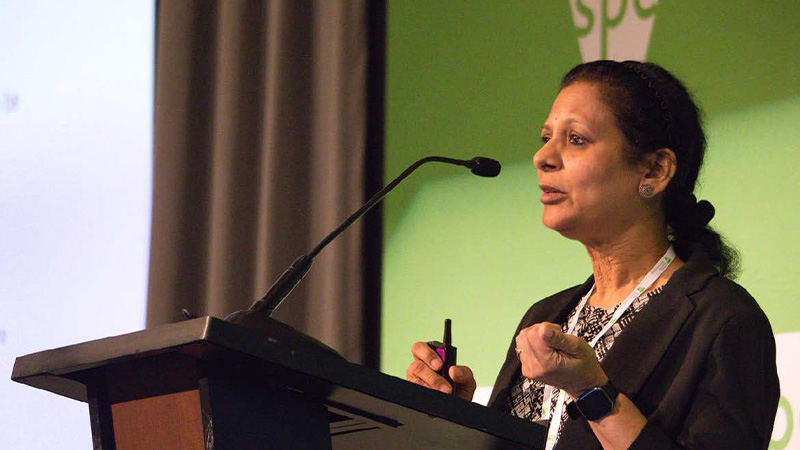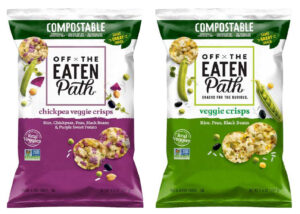PepsiCo Sees Biopolymers as Key to Sustainability in Flexible Packaging

Goal is for all packages to meet environmental standards and to significantly reduce virgin plastics use
PepsiCo Inc. continues to strive to move “beyond the bag and beyond the bottle” in the quest to minimize the impact of its packaging on the environment. At ANTEC® 2023 in Denver, Dr. Sridevi Narayan-Sarathy delivered a keynote address outlining the company’s sustainable packaging initiatives.
Created in 1965 from the merger of Pepsi-Cola and Frito-Lay, the Purchase, N.Y.-based company reported net revenue of $86 billion in 2022, derived from brands such as Gatorade, Mountain Dew, Lay’s, Doritos, Cheetos, Quaker, SodaStream and, of course, Pepsi.
Based in Plano, Tex., Narayan-Sarathy, who is both technical director of sustainable packaging and a PepsiCo R&D senior fellow, told attendees on March 28 that more than 80 percent of the company’s food products use flexible packaging. This has led it to look at biobased alternatives to reduce impact on the environment.
In fall 2021, PepsiCo introduced pep+ (PepsiCo Positive), which Chairman/CEO Ramon Laguarta said represented “a fundamental transformation of what we do and how we do it to create growth and shared value with sustainability and human capital at the center.”
PepsiCo’s stated sustainability goal is to design all its packaging to be recyclable, compostable, biodegradable or reusable by 2025, while reducing use of virgin plastics from non-renewable sources per serving 50 percent by 2030. It also wants to expand its use of biobased materials and increase use of recycled content to 50 percent by 2030.
PepsiCo’s flexible packaging is made of a highly optimized, multilayer structure of petroleum-derived materials. A Lay’s potato chip bag, for example, contains layers of low-density polyethylene and polypropylene, as well as a metalized layer. While the individual materials are sustainable from a use point of view, this combination is difficult to recycle
Still, Narayan-Sarathy, who joined PepsiCo in 2010, contends the food and beverage giant is progressing in its mission to reduce or eliminate flexible packaging waste. The firm has experimented with various bioplastics with the aim of creating compostable bags.
Indeed, a week after ANTEC, Frito-Lay and Quaker announced they were opening a Greenhouse Learning Center at its R&D headquarters in Plano. The center will be used to field test, measure and analyze compostable packaging with an aim to speed up the rate of innovation. The brands said their R&D packaging team will use the Greenhouse Learning Center to test the biodegradation properties of compostable packages in different environments. The aim is to accelerate learning, validate lab results through simultaneous, real-time experiments as packaging formulations are improved and iterate packaging solutions quicker. “By changing our own compostable snack packaging technologies we’re also looking forward to sharing these with the industry so we can make collective efforts to make these changes,” a brands representative reported.
As the second-largest food and beverage company in the world, “PepsiCo buys laminated film, makes bags, then fills them and sells them,” Narayan-Sarathy said. But with biobased packaging, the firm “started from scratch. … It’s been a multiyear journey.”
Composting is an alternative end-of-life option for food packaging, and plant-based biopolymers help to reduce greenhouse gas (GHG) emissions while also enabling compostability of flexible packaging. In fact, a life cycle analysis (LCA) shows that biopolymers such as PHA and PLA—polyhydroxy alkanoate and polylactic acid, respectively—generate roughly 60 percent fewer GHG emissions than polyolefins.
Narayan-Sarathy noted how blending biopolymers and adding mineral fillers or bio-fillers is one route to optimizing such materials, often improving their overall biodegradability.

PepsiCo is making its flexible packaging sustainable, which means more bioplastics. Off the Eaten Path is one of its brands. Courtesy of PepsiCo
The many options available require companies such as PepsiCo to take a systematic approach to identify the blends that best balance sustainability, performance, compostability and cost. And the journey to final packaging involves a number of conversion steps, including compounding, extrusion, metalizing, laminating and printing. The company uses a LCA tool to monitor the carbon footprint associated with each of these steps.
This has involved identifying biodegradable alternatives for all minor components of packaging. “All layers are designed to be compostable,” she said, adding that “we’re using biopolymer blends and only compost-certified inks.”
One issue is that biopolymers are inherently more sensitive to moisture than oil-based polymers, and moisture vapor transmission increases with higher temperature and relative humidity. “This makes moisture barrier the biggest challenge with PHA-based packaging,” she said.
This requires PepsiCo to find ways to improve moisture performance. At the same time, it is using biopolymer-based adhesives and coatings to enhance package performance.
